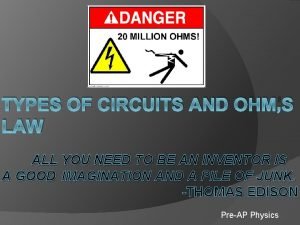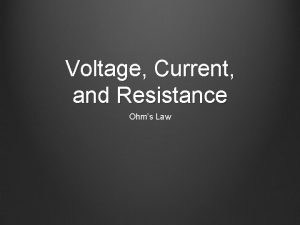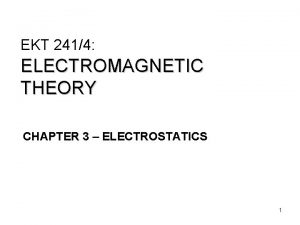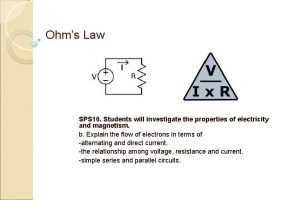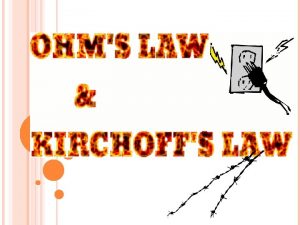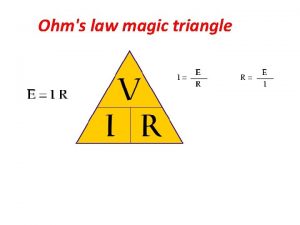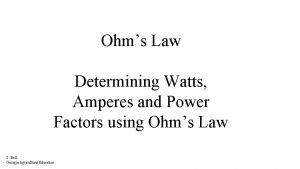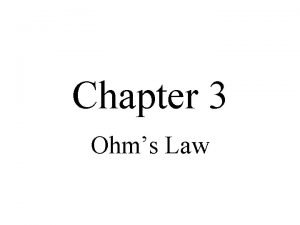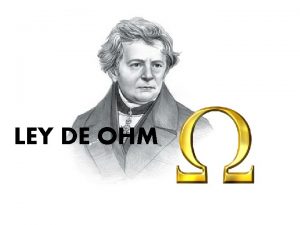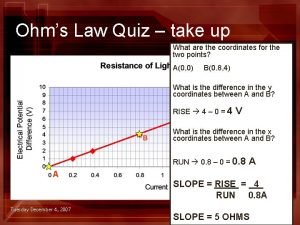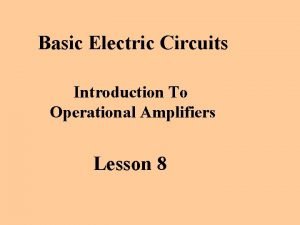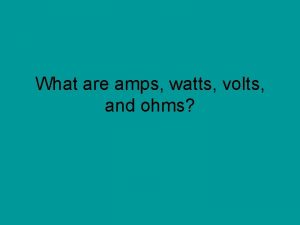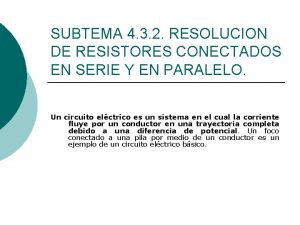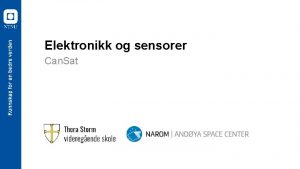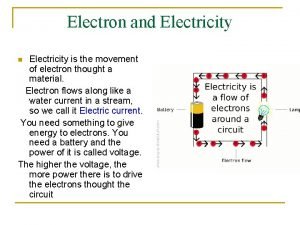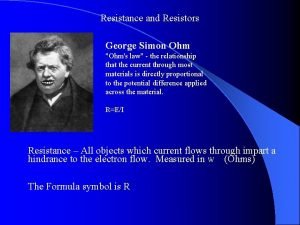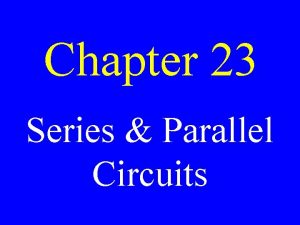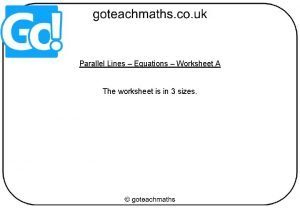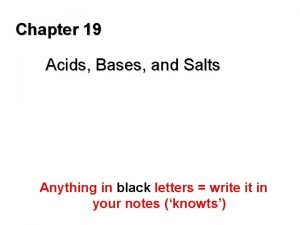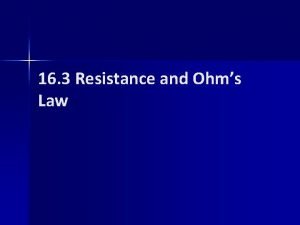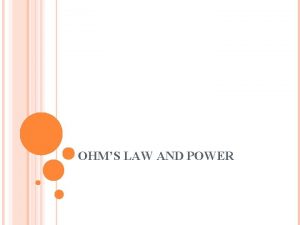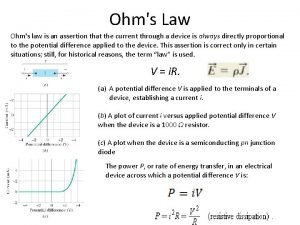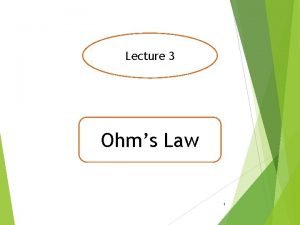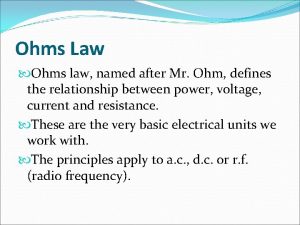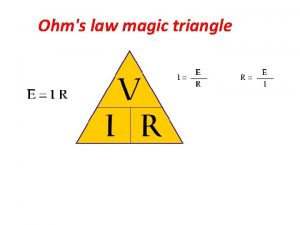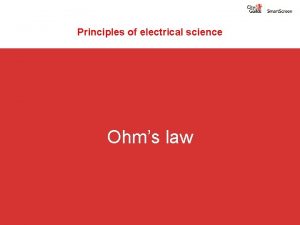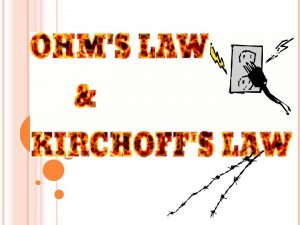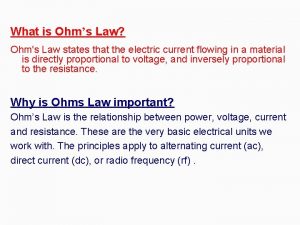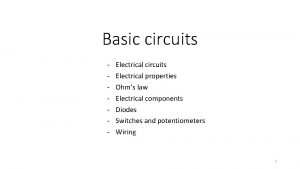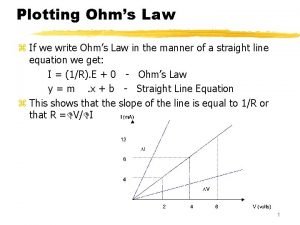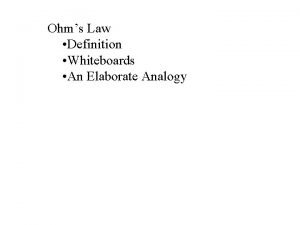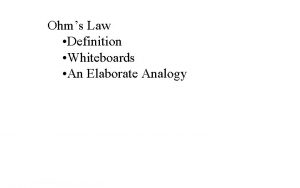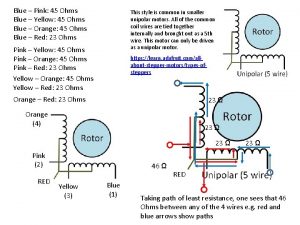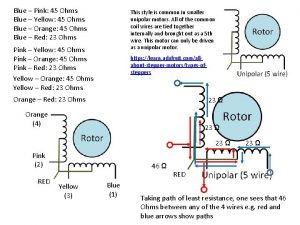Chapter 35 Worksheet Circuits and Ohms Law EQUATIONS



































- Slides: 35

Chapter 35 Worksheet: Circuits and Ohm’s Law

EQUATIONS

ELECTRICAL CIRCUIT SYMBOLS

1. Draw a circuit schematic (diagram) to include a 50. 0 V battery, an ammeter, and a resistance of 10. 0 Ω in series. A + 50. 0 V - 10. 0 Ω

a. What is the reading on the ammeter? A + 50. 0 V - 10. 0 Ω

b. In which direction is the current flowing? Conventional current (+) A + 50. 0 V 10. 0 Ω - Electron flow (-)

2. How much current flows through a radio speaker that has a resistance of 4. 0 Ω when 16 V is impressed across the speaker?

Draw a circuit diagram of the circuit described in the question above. Include a 6 V battery, an ammeter (labeled with value of current), and a resistance of 3. 0 Ω (the speaker). Also label the direction of the conventional (+) current. Conventional current 2 A A + 6 V - 3. 0 Ω

4. The following questions pertain to the circuit diagramed to the right. a. Lamp A reads a voltage of 12 V. What is the voltage of lamp B?

4. The following questions pertain to the circuit diagramed to the right. a. Lamp A reads a voltage of 12 V. What is the voltage of lamp B? Since this is a parallel circuit, the voltage in each branch of the circuit is equal to the voltage source. Therefore, Voltage is equal to 12 volts in each lamp

b. If the ammeters on both branches read the same amount, what does this tell you about the resistance of the two branches?

b. If the ammeters on both branches read the same amount, what does this tell you about the resistance of the two branches? Since this is parallel circuit, the resistance in each branch can be calculated with the following equation: Rearrange and get Since the voltage and current are the same in each branch, the resistance will be the same

c. If the current flowing in the first branch was 4. 0 A and 6. 0 A in the second branch, what would the total current in the circuit be?

c. If the current flowing in the first branch was 4. 0 A and 6. 0 A in the second branch, what would the total current in the circuit be? Total current in a parallel circuit can be calculated with the following equation:

5. Draw a series circuit diagram showing a 6. 0 V battery, a resistor, & an ammeter reading of 2. 0 A A 6. 0 V

a. Label: the size of the resistor, the direction of conventional current, the (+) and (-) terminals of the battery. 2. 0 A A 6. 0 V

a. Label: the size of the resistor, the direction of conventional current, the (+) and (-) terminals of the battery. Conventional current 2. 0 A A + 6. 0 V - 3Ω

b. Add a voltmeter to you diagram and indicate the potential difference across the resistor. 2. 0 A A 6. 0 V V 6. 0 V Therefore Vs = V 1 = 6. 0 V

6. Draw a circuit diagram showing a heater with a resistance of 6 Ω, and a potential difference source of 24. 0 V. A 24. 0 V 6Ω V

a. Calculate the current through the resistance A 24. 0 V 6Ω V

b. What thermal energy is supplied by the heater in 10 seconds? (HINT- use the equation E = I 2 Rt to determine energy) A 24. 0 V 6Ω V

7. Use the circuit diagram to the right to answer the following questions. a. What is the current flowing through this series circuit if the total resistance is 20 Ω?

b. What would the voltage across each of the three bulbs be? What could you say about the brightness of each of the bulbs? Therefore each bulb would have 8 volts and the same brightness

c. If two of the bulbs had a total resistance of 15 Ω, what would the resistance of the third bulb be? If the total resistance equals 20 ohms, then the remaining resistor would have a value of 5 ohms (20 – 15 = 5)

d. What would be the current flowing through the circuit be is the voltage source was 6. 0 V, and each of the lamps had a resistance of 2 Ω? First calculate total resistance Then plug into equation for current 6. 0 V 2Ω 2Ω 2Ω

8. Draw a circuit diagram showing three 10 Ω resistors connected in parallel and placed across a 60. 0 V battery. A 60. 0 V 10Ω 10Ω

a. What is the equivalent resistance of the parallel circuit? A 60. 0 V 10Ω Cross multiply and get 10Ω

b. What is the current through the entire circuit? R= 3. 3 Ω (from earlier problem) A 60. 0 V 10Ω 10Ω

c. What is the current through each branch of the circuit? A 60. 0 V 10Ω 10Ω Since the voltage and resistance are the same in each branch they would have the same current

9. Draw a circuit diagram showing the following: a 800. 0 Ω resistor, a 40 Ω resistor, and a 20 Ω resistor connected in parallel and connected across a 24. 0 V battery. A 24. 0 V 800Ω 40Ω 20Ω

a. What is the equivalent resistance of the parallel circuit? A 24. 0 V 800Ω Cross multiply and get 40Ω 20Ω

b. What is the current through the entire circuit? From above problem A 24. 0 V 800Ω 40Ω 20Ω

c. What is the current through each branch of the circuit? A 24. 0 V 800Ω 40Ω 20Ω

10. Answer the following questions about the circuit to the right. a. What do each of the 4 voltmeters read? 6 V In a parallel circuit, the voltage is the same through each branch and divided by the number of resistors in each branch. Therefore: VA = 6 V VB = 6 V VC = 3 V and VD = 3 V (voltage is split between the two resistors in that branch

b. If each of the resistors are identical, and the total current flowing through this parallel circuit is 12. 0 A, what is the total resistance of this circuit? 6 V
 Types of circuits
Types of circuits Chapter 35 electric circuits answers
Chapter 35 electric circuits answers Advantages of parallel circuits over series circuits
Advantages of parallel circuits over series circuits Https //phet.colorado.edu/en/simulation/ohms-law
Https //phet.colorado.edu/en/simulation/ohms-law Point form of ohms law
Point form of ohms law Ohms law resistance
Ohms law resistance State ohm's law of electricity
State ohm's law of electricity Triangle d'ohm
Triangle d'ohm Ohm's law states
Ohm's law states Ohms law emf
Ohms law emf Kirchoffs current law
Kirchoffs current law Ohm's law introduction
Ohm's law introduction Tungsten obeys ohms law because
Tungsten obeys ohms law because Derivation of ohm's law
Derivation of ohm's law Ley de ohm formula
Ley de ohm formula Ohm's law quiz
Ohm's law quiz Newton's first law and second law and third law
Newton's first law and second law and third law Newton's first law and second law and third law
Newton's first law and second law and third law Electric circuits equations
Electric circuits equations Complex circuits worksheet
Complex circuits worksheet Boyle's law charles law avogadro's law
Boyle's law charles law avogadro's law Avogadro's law constants
Avogadro's law constants Watts volts amps ohms
Watts volts amps ohms Dos focos uno de 70 ohm y otro de 80 ohm
Dos focos uno de 70 ohm y otro de 80 ohm Ohms lov
Ohms lov Movement of electricity
Movement of electricity High value resistances or rehostats are made by
High value resistances or rehostats are made by R7284u
R7284u Mikael ekman
Mikael ekman A 15 electric heater operates on a 120v outlet
A 15 electric heater operates on a 120v outlet Chapter 23 series and parallel circuits study guide answers
Chapter 23 series and parallel circuits study guide answers Alternate co interior and corresponding angles
Alternate co interior and corresponding angles Forming equations worksheet
Forming equations worksheet Chapter 4: exponential and logarithmic functions answer key
Chapter 4: exponential and logarithmic functions answer key Chapter 19 acids and bases worksheet answers
Chapter 19 acids and bases worksheet answers Balancing chemical equations worksheet with answers
Balancing chemical equations worksheet with answers
